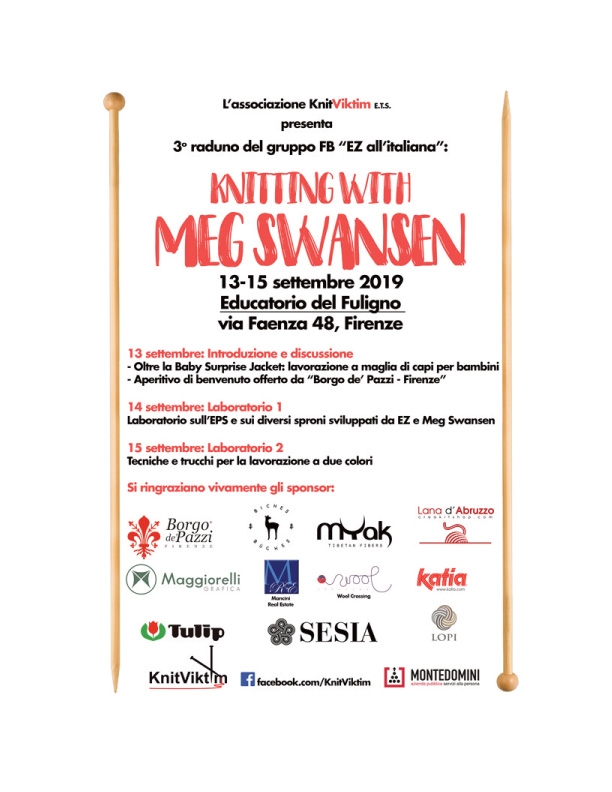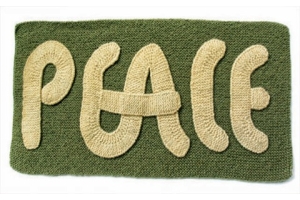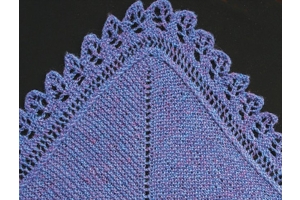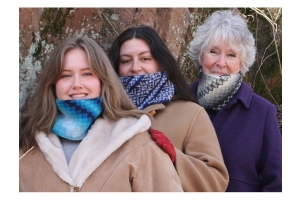Blog #25 Meg Swansen on Vests & Knitting Color Motifs

Dear Knitter,
Even as I type, Wool Gathering 101 is winging its way to subscribers’ mailboxes. I remain rather staggered by the fact that our WG issues now number into the hundreds - without even including EZ’s preceding 22 Newsletters.
The subject of 101 (2 pullover vests) is in response to requests for more men’s designs; although I consider both of the patterns in this issue to be gender neutral.
One of the vests is quite conventional; soft gray Shetland Spindrift wool with narrow stripes of a contrasting color. A deep ribbed lower edge, with v-neck and armholes bordered by narrow bands of ribbing.
The cover vest is color-patterned and worked with thicker wool, and has a rolled lower edge, with both v-neck and armholes bordered in 2-stitch I-Cord. It is not much heavier in weight, as it is knitted with 2-ply Unspun Icelandic wool, which seems to be mostly air, and is exceedingly snug. The small Faroese pattern is typical of the rich sweater-knitting history of those islands, and was taken from the historic 1921 book by Hans Debes: Foroysk Bindingarmynstur. And, speaking of Faroe books, there is now an English edition of Faerosk Strikkebog: Faroe Island Knits, Over 30 Traditional Motifs and 25 projects from the North Atlantic, by mother/daughter knitters Svanhild Strom and Marjun Biskopsto.
When knitting color motifs, in order to have an uninterrupted pattern, the motif-repeat must divide evenly into the number of body stitches. The smaller the repeat, the easier it is to make that happen, which is a distinct advantage of small Faroe patterns.
For example, the Wool Gathering’s Faroese Vest motif is a 5-stitch repeat, so if your stitch count is not evenly divisible by 5, you can easily adjust it without significantly altering the circumference (you would increase or decrease by only 2 sts, at most). Whereas, when you work with a 20-30 stitch Fair Isle oxo motif, it is unlikely that you have that multiple of body stitches, and you need to truncate the motifs for a mirror-image at each side ‘seam’, so that the pattern meets itself at the shoulder-top.
Some of the Faroe motifs are symmetric and some not; the one I use in the WG is not symmetric and therefore lent itself well to mirror-imaging at the center front and back and at each side. This is a nice effect to consider employing when choosing a motif - experiment by plotting them on graph paper, and see how you like the result.
You can see that design-options abound, and I encourage you to mix and match to create your own custom vest.
Below is a video in which I display some examples of Faroese Knitting - the pattern for my Tri-Patterned Faroese Sweater is available here, and the accompanying streaming video found here. The natural wool shades used in Faroese knitting lend themselves perfectly to our Unspun Icelandic Wool.
I feel a bit hurried as I write this: my living room is scattered with what my mother referred to as Heaps & Piles. This is in preparation for the trip Lloie and I are taking to Italy. I have been invited to Florence. How could I possibly refuse?
Interpreter and knitter Donna Galletta has organized the FB group Elizabeth Zimmermann all'italiana, and has worked long and hard to coordinate a knitting event which also includes a tantalizingly full marketplace of wool and books. And Donna sarà la mia voce during my visit. Below is the advertising poster she had made up:

This is Lloie’s and my 7th trip to Europe in recent years, and usually a title for each of these journeys presents itself as we travel. However, even before we depart, I have named this one: Grazie a Dio per il lavoro a maglia.
So, please wish us a Buon Viaggio, and Good Knitting,
Meg





